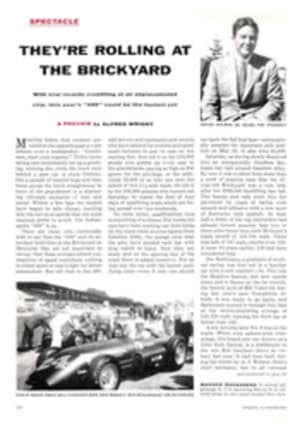
THE OUTDOOR WEEK
Based on regular weekly dispatches from SI bureaus and special correspondents in the U.S., Canada, Mexico and overseas; and on reports from fish and game commissions of the 48 states and Alaska
WHELE'S WHALE
Louis A. Wehle, a wealthy upstate brewer and confessed amateur biologist, who was appointed Conservation Commissioner of New York State by Governor Harriman in December 1954, has often jolted technicians with his unorthodox views on wildlife and conservation management. Last week Commissioner Wehle delivered his latest jolt in an announcement that he intended to build, on the banks of the St. Lawrence River, a $5 million, push-button-controlled, nuclear-powered trout hatchery.
According to Mr. Wehle he studied the problems of hatchery economics for some time and finally concluded that the cost to New York of $1.47 per pound of stocked fish was far too high, that it could be cut drastically.
The proposed hatchery to be preceded by a $150,000 pilot plant is a whale of a dream indeed. Tentatively scheduled for construction on a site below Long Sault Dam near Massena, optimum water temperatures will be maintained by the waste heat of a nuclear reactor. Each tank and pool will be filled or emptied automatically. When stocking from the air is feasible (presumably in lakes and ponds but not streams), trout will be drugged, packed in ice with one gill protruding (a method of eliminating tank trucks and aerating machinery which has been successfully used by other states when stocking by airplane) and flown to their destination from a landing strip next to the hatchery.
Although the plans for Mr. Wehle's vision are still on the drawing board, he is confident that its realization will produce bigger trout at less cost and enable New York to eliminate those hatcheries which he describes as still in the horse and buggy days. Just how the big operation will chop New York's present $1.47 cost per pound of stocked trout all the way to his own estimate of 50¢, Wehle is not sure.
It may be that any cut in costs of raising trout to plantable size could be more than offset by vastly increased expenditure for distribution since many of New York's present 22 hatcheries are on or close to a major stream.
This week Mr. Wehle's deputy, Justin T. Mahoney, will meet with federal officials in an effort to pry loose government funds for the project and the commissioner rightly or wrongly believes they will be forthcoming.
No qualified fisheries expert would comment this week on Mr. Wehle's vision. Should their reticence reflect an opposition developing in the state legislature and elsewhere, New York State is not yet about to be endowed with the world's first atomic trout hatchery.
If the project lives up to Mr. Wehle's predictions he will be remembered for a significant contribution to fisheries management. If it does not, he will have supplied fresh ammunition to those who believe untrained political appointees are more curse than boon to the cause of wildlife and conservation.
O PISCATOR VULGARIS!
The sporting mind boggles, but in Texas they are actually doing it. The angler is comfortably perched in his boat off the Gulf's oil rigs and drilling platforms. A diver goes overboard, carrying the angler's crab-baited hook and swims down to locate a jewfish, a species of sea bass that may weigh 500 pounds or more, prefers a forest of pilings as a homesite, and for all its prodigious bulk stages a rather feeble performance when hooked. Having spotted a fish, the diver gently chucks it under the chin. The grateful fish opens its mouth. The diver stuffs the hook therein and signals the angler above to crank up his hard-won trophy.
BEYOND DEATH'S DOOR
Many of the eagles returning north in spring to Wisconsin follow the line of the Door County peninsula, which thrusts a 60-mile-long finger out into Lake Michigan. Passing its tip, they cross Death's Door strait, so called because of the warriors who died there during Indian Wars, and come to Washington Island, where they build their aeries in the tall white pines, breed and raise their young, while the island below plays host to thousands of summer vacationers.
This spring a landmark for eagles and tourists alike is gone. The surviving twin of a pair of 400-year-old pines has now succumbed to dry rot; instead of its 200-foot-high crown, visitors this summer may look upon the logs into which the pine has been sawed and trace its life struggle in the scars carved by lightning, the gnarled healing of wind-racked limbs and the trails left by insects and birds in their predations.
A seedling long before the first white man crossed Death's Door, the tree was two years in dying; as with its twin, which had to be brought down in 1935, all efforts to save it were in vain.
There are other tall pines in Wisconsin, whites and Norways, and the eagles will undoubtedly find them. Vacationers will come to the island and, never having been awed by its 14-foot girth, will not miss the tree. A long life of service to man and bird is hereby marked.
FISHERMAN'S CALENDAR
SO—season opened (or opens); SC—season closed (or closes).
C—clear water; D—water dirty or roily; M—water muddy.
N—water at normal height; SH—slightly high; H—high; VH—very high; L—low; R—rising; F—falling.
WT50—water temperature 50°.
FG—fishing good; FF—fishing fair; FP—fishing poor; OG—outlook good; OF—outlook fair; OP—outlook poor
TROUT: NEW YORK: Heavy shadfly (Grannom) hatch on Beaverkill and Willowemoc last week, and local soothsayers predict FP until June 4 or 5. But season is screwed up by cold weather, hatches are far behind schedule and anything can happen.
NEW MEXICO: OF throughout the state with the exception of the Chama River, now H and M. High lakes and headwaters of the Pecos are in good shape for wet flies.
COLORADO: OP to OF as the season's first week found H and R water on such streams as Poudre, Gunnison, Arkansas, North Platte, Eagle and North Fork of the South Platte. OF for the Glenwood Springs area's Frying Pan, Roaring Fork and Crystal rivers which are all H but clearing.
CALIFORNIA: OF for bait fishermen in low elevations of northern counties as hot weather and storms increased the runoff from high snow fields. Higher elevations inaccessible to everything but four-wheel-drive vehicles, but best bets are the Truckee and Little Truckee for those who can reach them.
BRITISH COLUMBIA: Resort bookings are heavy for the holiday weekend and OG in Vancouver Island lakes as well as those in the interior. Shuswap Lake producing fine catches of 5-to 15-pound Kamloops trout on lures trolled near the surface.
NEW HAMPSHIRE: Water still very cold in most New Hampshire lakes and frost-bitten anglers are taking lake trout near surface on streamers. OF/G on most streams which are clear but cold. A sudden weather change could spell dry fly action.
MAINE: Ice is out on Moosehead and Rangeley lakes and OG for trollers who work coves, stream mouths and bars. Largest laker so far is a 13-pound 8-ounce fish from Branch Pond caught by Louis Boyle of Bangor.
PENNSYLVANIA: Most streams still H, R, WT 46-52 although the Big Spring and Yellow Breeches are yielding some fish on spinners and minnows. Hatches are still sporadic but hot weather could bring fast change for the better. Agent reports, however, most anglers losing confidence that hot weather will ever arrive.
STRIPED BASS: NEW JERSEY: Fish being taken all along northern coast with fair results at night off jetties at Long Branch. OF in Shrewsbury River with hottest spots Seabright, Rumson Bridge and old railroad bridge at Highlands. Trolling with spinner and worms or still-fishing with worms most productive methods.
MASSACHUSETTS: Early run of school fish to six pounds has hit Weweantic River near Ware-ham and Popponessett Beach on Cape Cod's south shore. OF/G as weather warms and larger fish move into Cape waters.
ATLANTIC SALMON: NOVA SCOTIA: 44 of the 64 fish taken in the province last week came from Annapolis County rivers. Heaviest, 22 pounds, killed in St. Mary's River, and OF/G for most waters.
NEW BRUNSWICK: High water on main Miramichi, Northwest and Little Southwest Renous caused poor results last week but OF/G if weather improves. Black salmon up to 25 pounds still showing in Cains River. St. John and Nashwaak rivers H but falling.
BRITISH COLUMBIA: FG generally along Vancouver Island coast and in Howe Sound for spring run fish. For Pender Harbor and Parksville, OF.
TARPON: FLORIDA: Tarpon reported all through keys with OVG as long as wind stays down. Large schools also in Tampa area with a 140-pounder taken from the Tampa Estuary in heart of city's shipping district by Miss Marian Sumner, a nurse. Boca Grande Pass on southwest coast living up to its claim as the world's tarpon capital with over 600 fish reported hooked so far in the pass. Spy reports tarpon are unusually large and most of those boated are released. OVG.
LOUISIANA: Denny Weinnig of New Orleans boated first tarpon of the year at Grand Isle. Some small schools have been sighted in Lake Ponchartrain, and OF/G.
BLACK BASS: FLORIDA: FG in most west coast waters; backwaters of Withlacoochee River above power company dam 80 miles north of Tampa is hottest spot. Little Lake Harris near Leesburg and Lake Warburg near Ocala also producing full strings. OGVG. Conditions in Lakeland area very serious as drought continues, and OVP unless heavy rains come soon.
TENNESSEE: Smallmouth and largemouth bass hitting surface lures better than in recent years, with OG. Cherokee Lake OF as some bass feed on surface. Douglas Lake at 3-year peak and FVG with surface lures. Loudon, Watts Bar, Fontana, Center Hill and Cumberland lakes OG. Pickwick Landing Reservoir OVG for smallmouths; Cecil Turner of Columbia netted a 6½-pounder on a fly rod.

